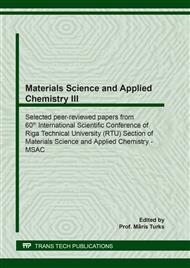[1]
H.Magnusson, The effect of degree of branching on the rheological and thermal properties of hyperbranched aliphatic polyethers, Polymer 43 (2) (2002) 301-306.
DOI: 10.1016/s0032-3861(01)00620-6
Google Scholar
[2]
Z. Grigale-Sorocina, I. Birks, Hectorite and bentonite effect on water-based polymer coating rheology, C. R. Chimie 22 (2019) 169-174.
DOI: 10.1016/j.crci.2018.11.011
Google Scholar
[3]
L.V. Kerai et al., UV curable gel formulations: Potential drug carriers for the topical treatment of nail diseases, Int. J. Pharm. 492 (2015) 177–190.
DOI: 10.1016/j.ijpharm.2015.07.020
Google Scholar
[4]
I. Vejnovic et al., Investigation of different formulations for drug delivery through the nail plate, Int. J. Pharm. 386 (2010) 185–194.
DOI: 10.1016/j.ijpharm.2009.11.019
Google Scholar
[5]
P.P. Shanbhag, U. Jani, Drug delivery through nails: Present and future, N. Hor. Trans. Med. 3 (2017) 252–263.
Google Scholar
[6]
S.Murdan, Drug delivery to the nail following topical application, Int. J. Pharm. 236 (2002) 1-26.
Google Scholar
[7]
N.I. El-sherif et al., In-situ gels and nail lacquers as potential delivery systems for treatment of onychomycosis. A comparative study, J. Drug. Deliv. Sci. Tec. 43 (2018) 253–261.
DOI: 10.1016/j.jddst.2017.10.018
Google Scholar
[8]
S. Naumann et al., Controlled nail delivery of a novel lipophilic antifungal agent using various modern drug carrier systems as well as in vitro and ex vivo model systems, J. Control. Release 180 (2014) 60–70.
DOI: 10.1016/j.jconrel.2014.02.013
Google Scholar
[9]
L.Farran, Tensile and shear properties of fingernails as a function of a changing humidity environment, J. Biomech. 2009, 42,1230-1235.
Google Scholar
[10]
C.J.G. Plummer et al., Correlating the rheological and mechanical response of polyurethane nanocomposites containing hyperbranched polymers, Polymer 46 (2005) 6543–6553.
DOI: 10.1016/j.polymer.2005.05.006
Google Scholar
[11]
E.S. Dzunuzovic et al., Mechanical and thermal properties of UV cured mixtures of linear and hyperbranched urethane acrylates, Progr. Org. Coat. 74 (2012) 158-164.
DOI: 10.1016/j.porgcoat.2011.12.004
Google Scholar
[12]
W.Hale et al., Effect of PBT melt viscosity on the morphology and mechanical properties of compatibilized and uncompatibilized blends with ABS, Polymer 40 (13) (1999) 3621-3629.
DOI: 10.1016/s0032-3861(98)00583-7
Google Scholar
[13]
C.F. Antunes et al., Morphology and phase inversion of EPDM/PP blends–Effect of viscosityand elasticity, Polym. Test. 30 (2011) 907–915908.
Google Scholar


